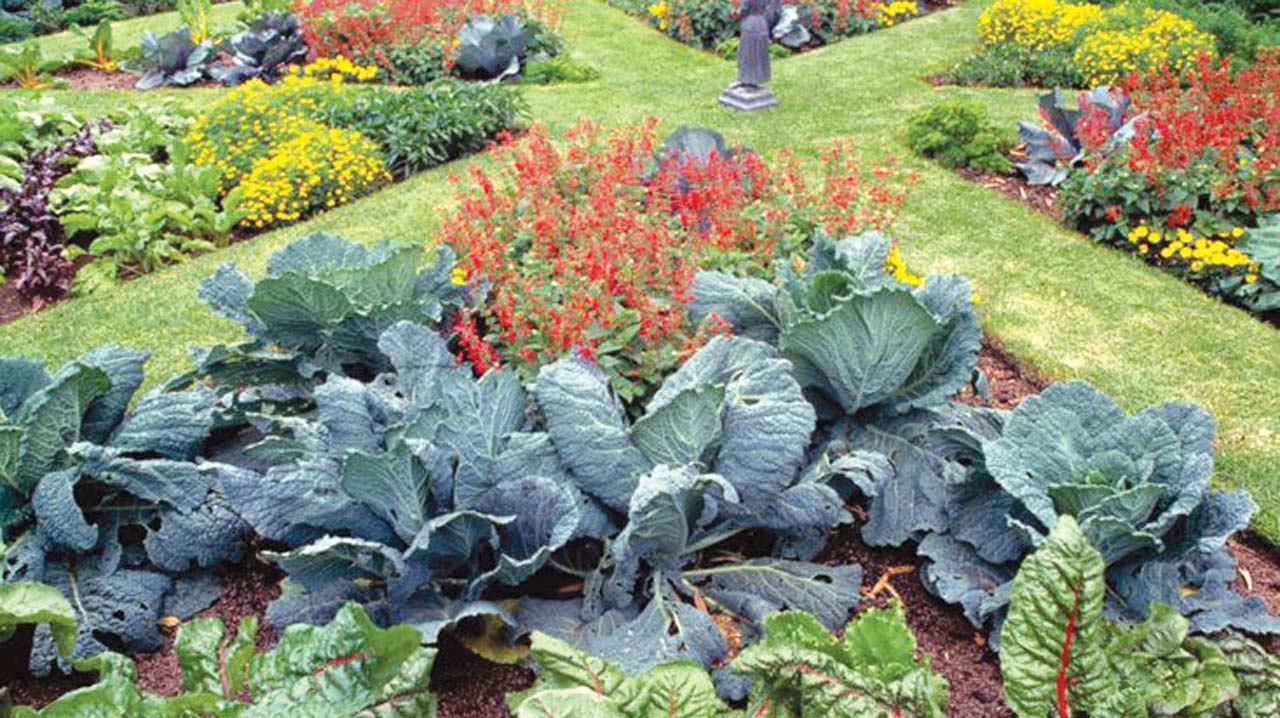Edible landscaping
Foodscaping otherwise called edible landscaping is the practical integration of food plants in an ornamental or decorative setting. The same design principles as ornamental landscaping are used, except edible plants such as herbs, vegetables, and fruit trees are used in combination with ornamental foliage and flowering plants. Integrating both edibles and ornamentals is a most efficient way to produce a garden that is flavorful, practical and beautiful.
Foodscaping is equally as beautiful, and is a much more productive use of the soil. Using edibles in landscape design not only provides a unique ornamental component, but also provides healthy food and economic benefits.
In fact, many ornamentals can be used as visually appealing, organic bug repellants for garden plants. Marigolds, and petunias are all appraised for their pest repelling qualities, are low maintenance, season-long bloomers.
In the beginning…
There were simply beautiful plants. Then when it was discovered that some were good to eat – their fruit, foliage, roots, or flowers providing the calories and nutrition required to assure mankind’s survival – it made sense to grow them in special protected area to guarantee an adequate, convenient supply.
Ever since, with a few exceptions, food gardens have been distinct from the natural landscape. Often in today’s deliberately landscaped gardens, edible plants are still relegated to the wings, while the center stage being reserved for ornamental plants. Until relative recently space seemed unlimited, so combining practical and ornamental plants seemed unnecessary. So, food gardens followed the agricultural model, designs to be easy to tend and to harvest. These utilitarian gardens were kept out of sight in the backyard, decorative plants were plants that were on view from the street.
Today, it’s Foodscaping …
Where edibles and ornamentals are brought together to celebrate equally their beauty and edible value. Gardeners have a new appreciation for their foliage, fruit, seedpods, habit, and bark. They recognize that many food plants have ornamental features. What can be lovelier than a lush red unique okra plant with decorative leaves and a creamy yellow hibiscus-like bloom? Second, space for both edible and decorative plants is at a premium now that residential yards are shrinking. Since the 1980s, the typical backyard food garden has shrunk due to the rise of urbanism. Foodscaping is where the future gardening will be found.
Consider replacing the typical landscape with decorative borders of herbs, rainbow chards and striking chili peppers. Homeowners with small or large gardens can benefit from a trellis of cherry tomatoes cascading over the entryway, a fragrant border of colorful and flavorful basils, amaranths (shokoyokoto, spinach) or a semi-dwarf pawpaw tree or two. There are tasty and ornamental edible plants for just about any garden setting in any climate.
Edible Edges
Almost every type of edible can find a home in the landscape, but some plants are better suited for certain locations than others. In the garden, half the battle is planting the right plant in the right place. The other half is planting the right plant at the right time.
Matching the plant to the place is the key to efficiently using your space and available sunlight to grow the maximum amount of food. The easiest way to incorporate edibles into your foundation landscape is along the edges. This is where the sun is usually most plentiful and it’s an area that is easy to reach for planting, watering and harvesting.
Container Gardening
Gardening in containers has become popular, so blending both types of plants in even more confined spaces such as porches, verandah and balconies can produce food as well as flowers. Third, we have rediscovered herbs, especially culinary herbs that are flavorful, they are at home in both the vegetable patch and the ornamental bed.
They are leading the way to integrate the two worlds into foodscaping as we discover how to edge a flowerbed with neat clumps of basil.
It is but a small step to incorporate the smooth, globe-shape bulbs of onions or Fennel Antares with its many uses including an edible bulb; ornamental fronds; a seed producer; and as a favourite food of pollinators, namely swallowtail caterpillars into a bed of traditional decorative annuals. Lastly there are the new, gorgeous varieties of food plants. They beg to be on display, destroying the rigid distinction between edible and ornamental.
Bright light colorful stems of Swiss chard and textured leaves are so beautiful they grace calendars and magazines front covers and the colorful fruits and rich purple foliage of some pepper cultivars is the subject of fine art. New dwarf forms of food plants makes it easier to grow in containers among the geraniums and petunias.
Foodscaping in containers with cultivars specifically bred for containers brings the best of both worlds together.
Extending Foodscaping Gardening
Take advantage of the colors of mixed lettuces, purple basil, red okra, red, yellow and orange peppers; yellow, orange, and green tomatoes; purple eggplants; speckled watermelons and savoy cabbage. Celebrate the shapes of pear tomatoes, skinny eggplants, marbled sized tomatoes, and yard long green beans. Foodscaping makes more efficient use of available space and light and increases the number of different crops you can grow. It also maximizes production by extending the space for food crops. It eliminates the struggle to decide which gets the best sun in the garden, the roses or the peppers. Put them both in the sunny spot, even if it is the front yard. If the best sun is over the porch, plant tomatoes with flowers in hanging baskets off the porch roof. Plant a patio type tomato in a container surrounded with African marigolds on the balcony. Prune the tomato’s lower branches to make room for the marigolds to branch out. Other combos might be eggplants with petunias, peppers plus red salvia, salad bush, cucumber, and calendulas. Plant squash or sweet potato vine in a window or railing box and let it trail over the edge. Then fill in the box with a more upright annual such as geraniums. Combining families of edible and ornamental types of plants improves their health.
As the diversity of plantings in all parts of the garden increases so does the diversity of beneficial insects, the first line of defense against pest insects. Blending more species in various ways rotates your food crops more effectively in new, smaller gardens. Foodscaping gardens are beautiful, bountiful, and enhance the environment.
Benefits of Foodscaping
Energy Savings: food from your garden requires no transporting, shipping and little refrigeration. Plus commercial farms use a large amount of energy to plow, plant, spray and harvest produce. Planting and picking tomatoes in your front garden requires a miniscule amount by comparison.
Food Safety: you know which chemical (if any) are used.
Money Saving: an unbelievable amount of food can be grown in a small, beautiful space. An average family will save much cost on groceries by growing their own food.
Better Nutrition: fully ripe, just picked, homegrown fruits and vegetables provide more vitamins and nutrients than market produce, which is usually picked under ripe and is days, even weeks old when eaten.











